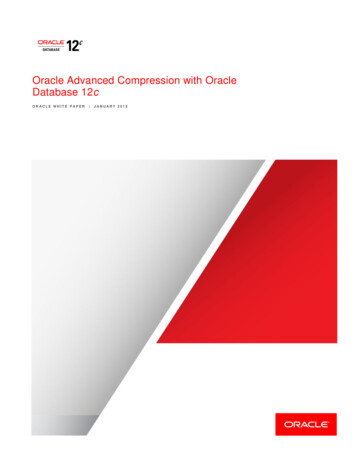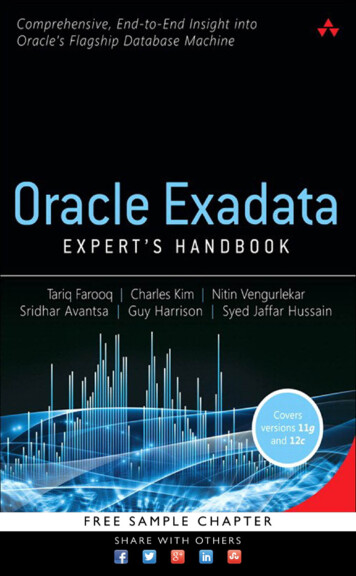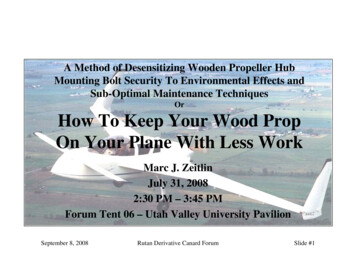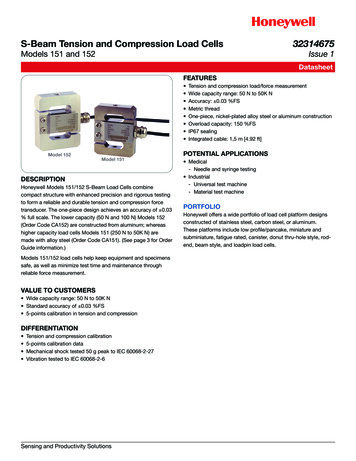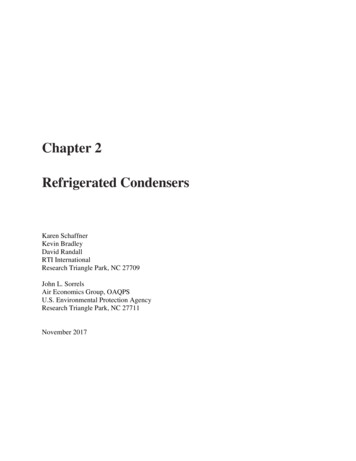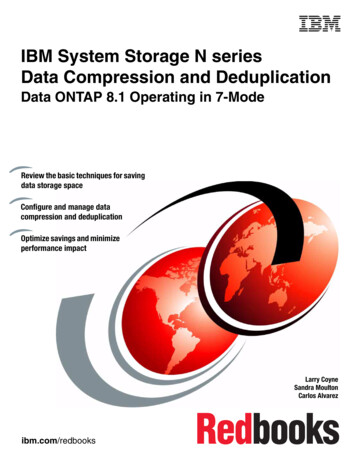
Transcription
Front coverIBM System Storage N seriesData Compression and DeduplicationData ONTAP 8.1 Operating in 7-ModeReview the basic techniques for savingdata storage spaceConfigure and manage datacompression and deduplicationOptimize savings and minimizeperformance impactLarry CoyneSandra MoultonCarlos Alvarezibm.com/redbooks
International Technical Support OrganizationIBM System Storage N series Data Compression andDeduplication: Data ONTAP 8.1 Operating in 7-ModeJuly 2012SG24-8033-00
Note: Before using this information and the product it supports, read the information in “Notices” onpage vii.First Edition (July 2012)This edition applies to Version 8.1 of Data ONTAP. It also applies to IBM System Storage N series. Copyright International Business Machines Corporation 2012. All rights reserved.Note to U.S. Government Users Restricted Rights -- Use, duplication or disclosure restricted by GSA ADP ScheduleContract with IBM Corp.
ContentsNotices . . . . . . . . . . . . . . . . . . . . . . . . . . . . . . . . . . . . . . . . . . . . . . . . . . . . . . . . . . . . . . . . . viiTrademarks . . . . . . . . . . . . . . . . . . . . . . . . . . . . . . . . . . . . . . . . . . . . . . . . . . . . . . . . . . . . . viiiPreface . . . . . . . . . . . . . . . . . . . . . . . . . . . . . . . . . . . . . . . . . . . . . . . . . . . . . . . . . . . . . . . . . ixThe team who wrote this book . . . . . . . . . . . . . . . . . . . . . . . . . . . . . . . . . . . . . . . . . . . . . . . . ixNow you can become a published author, too! . . . . . . . . . . . . . . . . . . . . . . . . . . . . . . . . . . . .xComments welcome. . . . . . . . . . . . . . . . . . . . . . . . . . . . . . . . . . . . . . . . . . . . . . . . . . . . . . . . .xStay connected to IBM Redbooks . . . . . . . . . . . . . . . . . . . . . . . . . . . . . . . . . . . . . . . . . . . . . .xChapter 1. Basic concepts . . . . . . . . . . . . . . . . . . . . . . . . . . . . . . . . . . . . . . . . . . . . . . . . .1.1 N series deduplication . . . . . . . . . . . . . . . . . . . . . . . . . . . . . . . . . . . . . . . . . . . . . . . . . . .1.1.1 Deduplicated volumes. . . . . . . . . . . . . . . . . . . . . . . . . . . . . . . . . . . . . . . . . . . . . . .1.1.2 Deduplication metadata . . . . . . . . . . . . . . . . . . . . . . . . . . . . . . . . . . . . . . . . . . . . .1.1.3 Deduplication metadata overhead . . . . . . . . . . . . . . . . . . . . . . . . . . . . . . . . . . . . .1.2 N series data compression . . . . . . . . . . . . . . . . . . . . . . . . . . . . . . . . . . . . . . . . . . . . . . .1.2.1 How N series data compression works . . . . . . . . . . . . . . . . . . . . . . . . . . . . . . . . . .1.2.2 When data compression runs . . . . . . . . . . . . . . . . . . . . . . . . . . . . . . . . . . . . . . . . .1.3 General compression and deduplication features . . . . . . . . . . . . . . . . . . . . . . . . . . . . . .123345567Chapter 2. Why use data compression and deduplication? . . . . . . . . . . . . . . . . . . . . . . 92.1 Considerations by type of application . . . . . . . . . . . . . . . . . . . . . . . . . . . . . . . . . . . . . . 102.2 Inline compression versus post-process compression . . . . . . . . . . . . . . . . . . . . . . . . . 112.3 Space savings . . . . . . . . . . . . . . . . . . . . . . . . . . . . . . . . . . . . . . . . . . . . . . . . . . . . . . . . 112.4 Factors that affect savings . . . . . . . . . . . . . . . . . . . . . . . . . . . . . . . . . . . . . . . . . . . . . . 122.4.1 Type of data . . . . . . . . . . . . . . . . . . . . . . . . . . . . . . . . . . . . . . . . . . . . . . . . . . . . . 122.4.2 Snapshot copies . . . . . . . . . . . . . . . . . . . . . . . . . . . . . . . . . . . . . . . . . . . . . . . . . 132.4.3 Space savings of existing data . . . . . . . . . . . . . . . . . . . . . . . . . . . . . . . . . . . . . . 132.4.4 Deduplication metadata . . . . . . . . . . . . . . . . . . . . . . . . . . . . . . . . . . . . . . . . . . . . 142.4.5 Data that will not compress or deduplicate . . . . . . . . . . . . . . . . . . . . . . . . . . . . . 142.5 Space Savings Estimation Tool (SSET) . . . . . . . . . . . . . . . . . . . . . . . . . . . . . . . . . . . . 142.5.1 Overview of SSET. . . . . . . . . . . . . . . . . . . . . . . . . . . . . . . . . . . . . . . . . . . . . . . . . 142.5.2 Limitations of SSET . . . . . . . . . . . . . . . . . . . . . . . . . . . . . . . . . . . . . . . . . . . . . . . 15Chapter 3. Performance . . . . . . . . . . . . . . . . . . . . . . . . . . . . . . . . . . . . . . . . . . . . . . . . . .3.1 Factors influencing performance . . . . . . . . . . . . . . . . . . . . . . . . . . . . . . . . . . . . . . . . . .3.2 Performance of compression and deduplication operations . . . . . . . . . . . . . . . . . . . . .3.2.1 Inline compression performance . . . . . . . . . . . . . . . . . . . . . . . . . . . . . . . . . . . . . .3.2.2 Considerations . . . . . . . . . . . . . . . . . . . . . . . . . . . . . . . . . . . . . . . . . . . . . . . . . . .3.3 Impact on the system during compression and deduplication processes . . . . . . . . . . .3.4 Impact on the system from inline compression . . . . . . . . . . . . . . . . . . . . . . . . . . . . . . .3.5 I/O performance of deduplicated volumes . . . . . . . . . . . . . . . . . . . . . . . . . . . . . . . . . .3.5.1 Write performance of deduplicated volumes. . . . . . . . . . . . . . . . . . . . . . . . . . . . .3.5.2 Read performance of a deduplicated volume . . . . . . . . . . . . . . . . . . . . . . . . . . . .3.5.3 Workload impact while deduplication process is active . . . . . . . . . . . . . . . . . . . .3.6 I/O performance of compressed volumes . . . . . . . . . . . . . . . . . . . . . . . . . . . . . . . . . . .3.6.1 Write performance of a compressed volume . . . . . . . . . . . . . . . . . . . . . . . . . . . .3.6.2 Read performance of a compressed volume . . . . . . . . . . . . . . . . . . . . . . . . . . . .3.7 PAM and Flash Cache cards . . . . . . . . . . . . . . . . . . . . . . . . . . . . . . . . . . . . . . . . . . . .3.8 Suggestions for optimal savings and minimal performance overhead . . . . . . . . . . . . . Copyright IBM Corp. 2012. All rights reserved.17181920202021212122222223232424iii
Chapter 4. Implementation and upgrade considerations . . . . . . . . . . . . . . . . . . . . . . .4.1 Evaluating the techniques . . . . . . . . . . . . . . . . . . . . . . . . . . . . . . . . . . . . . . . . . . . . . . .4.2 VMware . . . . . . . . . . . . . . . . . . . . . . . . . . . . . . . . . . . . . . . . . . . . . . . . . . . . . . . . . . . . .4.3 Microsoft SharePoint . . . . . . . . . . . . . . . . . . . . . . . . . . . . . . . . . . . . . . . . . . . . . . . . . . .4.4 Microsoft SQL Server . . . . . . . . . . . . . . . . . . . . . . . . . . . . . . . . . . . . . . . . . . . . . . . . . .4.5 Microsoft Exchange Server . . . . . . . . . . . . . . . . . . . . . . . . . . . . . . . . . . . . . . . . . . . . . .4.6 Lotus Domino . . . . . . . . . . . . . . . . . . . . . . . . . . . . . . . . . . . . . . . . . . . . . . . . . . . . . . . .4.7 Oracle . . . . . . . . . . . . . . . . . . . . . . . . . . . . . . . . . . . . . . . . . . . . . . . . . . . . . . . . . . . . . .4.8 Tivoli Storage Manager . . . . . . . . . . . . . . . . . . . . . . . . . . . . . . . . . . . . . . . . . . . . . . . . .4.9 Symantec Backup Exec . . . . . . . . . . . . . . . . . . . . . . . . . . . . . . . . . . . . . . . . . . . . . . . .4.10 Data backups . . . . . . . . . . . . . . . . . . . . . . . . . . . . . . . . . . . . . . . . . . . . . . . . . . . . . . .4.11 Upgrading and reverting . . . . . . . . . . . . . . . . . . . . . . . . . . . . . . . . . . . . . . . . . . . . . . .4.11.1 Upgrading to Data ONTAP 8.1 . . . . . . . . . . . . . . . . . . . . . . . . . . . . . . . . . . . . . .4.11.2 Reverting to an earlier version of Data ONTAP . . . . . . . . . . . . . . . . . . . . . . . . .2526262727282828292929303030Chapter 5. Configuration and operation . . . . . . . . . . . . . . . . . . . . . . . . . . . . . . . . . . . . .5.1 Requirements . . . . . . . . . . . . . . . . . . . . . . . . . . . . . . . . . . . . . . . . . . . . . . . . . . . . . . . .5.2 Maximum logical data size limit. . . . . . . . . . . . . . . . . . . . . . . . . . . . . . . . . . . . . . . . . . .5.3 Command summary . . . . . . . . . . . . . . . . . . . . . . . . . . . . . . . . . . . . . . . . . . . . . . . . . . .5.4 Interpreting space usage and savings . . . . . . . . . . . . . . . . . . . . . . . . . . . . . . . . . . . . .5.5 Compression and deduplication options for existing data . . . . . . . . . . . . . . . . . . . . . . .5.6 Guidelines for compressing existing data . . . . . . . . . . . . . . . . . . . . . . . . . . . . . . . . . . .5.7 Compression and deduplication quick start . . . . . . . . . . . . . . . . . . . . . . . . . . . . . . . . .5.8 Configuring compression and deduplication schedules . . . . . . . . . . . . . . . . . . . . . . . .5.9 End-to-end compression and deduplication examples . . . . . . . . . . . . . . . . . . . . . . . . .33343435383840404142Chapter 6. Compression and deduplication with other N series features. . . . . . . . . .6.1 Management tools. . . . . . . . . . . . . . . . . . . . . . . . . . . . . . . . . . . . . . . . . . . . . . . . . . . . .6.2 Data protection . . . . . . . . . . . . . . . . . . . . . . . . . . . . . . . . . . . . . . . . . . . . . . . . . . . . . . .6.3 High availability technologies . . . . . . . . . . . . . . . . . . . . . . . . . . . . . . . . . . . . . . . . . . . .6.4 Other N series features . . . . . . . . . . . . . . . . . . . . . . . . . . . . . . . . . . . . . . . . . . . . . . . . .4950505658Chapter 7. Troubleshooting . . . . . . . . . . . . . . . . . . . . . . . . . . . . . . . . . . . . . . . . . . . . . . . 677.1 Maximum logical data size limits . . . . . . . . . . . . . . . . . . . . . . . . . . . . . . . . . . . . . . . . . . 687.2 Post-process operations take too long to complete . . . . . . . . . . . . . . . . . . . . . . . . . . . 687.3 Lower than expected space savings . . . . . . . . . . . . . . . . . . . . . . . . . . . . . . . . . . . . . . . 687.4 Slower than expected performance . . . . . . . . . . . . . . . . . . . . . . . . . . . . . . . . . . . . . . . 717.5 Removing space savings . . . . . . . . . . . . . . . . . . . . . . . . . . . . . . . . . . . . . . . . . . . . . . . 737.5.1 Uncompressing a flexible volume . . . . . . . . . . . . . . . . . . . . . . . . . . . . . . . . . . . . 747.5.2 Undeduplicating a flexible volume . . . . . . . . . . . . . . . . . . . . . . . . . . . . . . . . . . . . 757.5.3 Uncompressing and undeduplicating a flexible volume . . . . . . . . . . . . . . . . . . . . 777.6 Logs and error messages . . . . . . . . . . . . . . . . . . . . . . . . . . . . . . . . . . . . . . . . . . . . . . . 787.6.1 Compression- and deduplication-related event messages . . . . . . . . . . . . . . . . . 807.7 Understanding OnCommand Unified Manager event messages . . . . . . . . . . . . . . . . . 817.8 Additional compression and deduplication reporting. . . . . . . . . . . . . . . . . . . . . . . . . . . 817.8.1 Reporting more details about the most recent compression and deduplication . . 827.8.2 Reporting more details about compression and deduplication history over the entirelife of the volume . . . . . . . . . . . . . . . . . . . . . . . . . . . . . . . . . . . . . . . . . . . . . . . . . 837.9 Where to get more help. . . . . . . . . . . . . . . . . . . . . . . . . . . . . . . . . . . . . . . . . . . . . . . . . 877.9.1 Useful information to gather before contacting support . . . . . . . . . . . . . . . . . . . . 87Related publications . . . . . . . . . . . . . . . . . . . . . . . . . . . . . . . . . . . . . . . . . . . . . . . . . . . . . 89IBM Redbooks . . . . . . . . . . . . . . . . . . . . . . . . . . . . . . . . . . . . . . . . . . . . . . . . . . . . . . . . . . . 89Other publications . . . . . . . . . . . . . . . . . . . . . . . . . . . . . . . . . . . . . . . . . . . . . . . . . . . . . . . . 89ivIBM System Storage N series Data Compression and Deduplication: Data ONTAP 8.1 Operating in 7-Mode
Online resources . . . . . . . . . . . . . . . . . . . . . . . . . . . . . . . . . . . . . . . . . . . . . . . . . . . . . . . . . 90How to get IBM Redbooks Publications . . . . . . . . . . . . . . . . . . . . . . . . . . . . . . . . . . . . . . . . 90Help from IBM . . . . . . . . . . . . . . . . . . . . . . . . . . . . . . . . . . . . . . . . . . . . . . . . . . . . . . . . . . . 90Index . . . . . . . . . . . . . . . . . . . . . . . . . . . . . . . . . . . . . . . . . . . . . . . . . . . . . . . . . . . . . . . . . . 91Contentsv
viIBM System Storage N series Data Compression and Deduplication: Data ONTAP 8.1 Operating in 7-Mode
NoticesThis information was developed for products and services offered in the U.S.A.IBM may not offer the products, services, or features discussed in this document in other countries. Consultyour local IBM representative for information on the products and services currently available in your area. Anyreference to an IBM product, program, or service is not intended to state or imply that only that IBM product,program, or service may be used. Any functionally equivalent product, program, or service that does notinfringe any IBM intellectual property right may be used instead. However, it is the user's responsibility toevaluate and verify the operation of any non-IBM product, program, or service.IBM may have patents or pending patent applications covering subject matter described in this document. Thefurnishing of this document does not give you any license to these patents. You can send license inquiries, inwriting, to:IBM Director of Licensing, IBM Corporation, North Castle Drive, Armonk, NY 10504-1785 U.S.A.The following paragraph does not apply to the United Kingdom or any other country where suchprovisions are inconsistent with local law: INTERNATIONAL BUSINESS MACHINES CORPORATIONPROVIDES THIS PUBLICATION "AS IS" WITHOUT WARRANTY OF ANY KIND, EITHER EXPRESS ORIMPLIED, INCLUDING, BUT NOT LIMITED TO, THE IMPLIED WARRANTIES OF NON-INFRINGEMENT,MERCHANTABILITY OR FITNESS FOR A PARTICULAR PURPOSE. Some states do not allow disclaimer ofexpress or implied warranties in certain transactions, therefore, this statement may not apply to you.This information could include technical inaccuracies or typographical errors. Changes are periodically madeto the information herein; these changes will be incorporated in new editions of the publication. IBM may makeimprovements and/or changes in the product(s) and/or the program(s) described in this publication at any timewithout notice.Any references in this information to non-IBM websites are provided for convenience only and do not in anymanner serve as an endorsement of those websites. The materials at those websites are not part of thematerials for this IBM product and use of those websites is at your own risk.IBM may use or distribute any of the information you supply in any way it believes appropriate without incurringany obligation to you.Information concerning non-IBM products was obtained from the suppliers of those products, their publishedannouncements or other publicly available sources. IBM has not tested those products and cannot confirm theaccuracy of performance, compatibility or any other claims related to non-IBM products. Questions on thecapabilities of non-IBM products should be addressed to the suppliers of those products.This information contains examples of data and reports used in daily business operations. To illustrate themas completely as possible, the examples include the names of individuals, companies, brands, and products.All of these names are fictitious and any similarity to the names and addresses used by an actual businessenterprise is entirely coincidental.COPYRIGHT LICENSE:This information contains sample application programs in source language, which illustrate programmingtechniques on various operating platforms. You may copy, modify, and distribute these sample programs inany form without payment to IBM, for the purposes of developing, using, marketing or distributing applicationprograms conforming to the application programming interface for the operating platform for which the sampleprograms are written. These examples have not been thoroughly tested under all conditions. IBM, therefore,cannot guarantee or imply reliability, serviceability, or function of these programs. Copyright IBM Corp. 2012. All rights reserved.vii
TrademarksIBM, the IBM logo, and ibm.com are trademarks or registered trademarks of International Business MachinesCorporation in the United States, other countries, or both. These and other IBM trademarked terms aremarked on their first occurrence in this information with the appropriate symbol ( or ), indicating USregistered or common law trademarks owned by IBM at the time this information was published. Suchtrademarks may also be registered or common law trademarks in other countries. A current list of IBMtrademarks is available on the Web at http://www.ibm.com/legal/copytrade.shtmlThe following terms are trademarks of the International Business Machines Corporation in the United States,other countries, or both:Domino IBM Redbooks Redbooks (logo) System Storage Tivoli The following terms are trademarks of other companies:Linux is a trademark of Linus Torvalds in the United States, other countries, or both.Microsoft, Windows, and the Windows logo are trademarks of Microsoft Corporation in the United States,other countries, or both.AutoSupport, OnCommand, DataMotion, Snapshot, WAFL, SyncMirror, SnapVault, SnapRestore,SnapMirror, SnapLock, SnapDrive, MultiStore, MetroCluster, FlexCache, FlexVol, FlexClone, Data ONTAP,vFiler, NetApp, and the NetApp logo are trademarks or registered trademarks of NetApp, Inc. in the U.S. andother countries.Intel, Intel logo, Intel Inside, Intel Inside logo, Intel Centrino, Intel Centrino logo, Celeron, Intel Xeon, IntelSpeedStep, Itanium, and Pentium are trademarks or registered trademarks of Intel Corporation or itssubsidiaries in the United States and other countries.Other company, product, or service names may be trademarks or service marks of others.viiiN series Data Compression and Deduplication with Data ONTAP 8.1
PrefaceOne of the biggest challenges for companies today continues to be the cost of data storage,which is a large and rapidly growing IT expense. IBM System Storage N seriesincorporates a variety of storage efficiency technologies to help organizations lower this cost.This IBM Redbooks publication focuses on two key components: N series deduplication anddata compression. In this book we describe in detail how to implement and use bothtechnologies and provide information on preferred practices, operational considerations, andtroubleshooting.N series data compression and deduplication technologies can work independently ortogether to achieve optimal savings. We explain how N series data compression anddeduplication work with Data ONTAP 8.1 operating in 7-Mode. We help you decide when touse compression and deduplication based on applications and data types to balance spacesaving against potential overhead. Optimization and usage considerations are included tohelp you determine your space savings.The team who wrote this bookThis book was produced by a team of specialists from around the world working with theInternational Technical Support Organization, Tucson Center.Larry Coyne is a project leader at the International Technical Support Organization inTucson, Arizona. He has 28 years of IBM experience, including 23 in IBM storage softwaremanagement. He holds degrees in Software Engineering from the University of Texas at ElPaso and Project Management from George Washington University. His areas of expertiseinclude client relationship management, quality assurance, development management, andsupport management for IBM Tivoli Storage Software.Sandra Moulton is a Senior Technical Marketing Engineer at NetApp. Since joining NetAppin 2009, Sandra has focused almost exclusively on storage efficiency, specializing indeduplication and data compression; she has been responsible for developingimplementation guides, technical white papers, reference architectures, solution and bestpractice guides for these critical technologies. Sandra has over 20 years of industryexperience, including performing similar functions at other leading Silicon Valley companies.Carlos Alvarez is a Senior Technical Marketing Engineer at Netapp. Carlos has been withNetApp since 2008, specializing in storage efficiency with deep-dive expertise indeduplication, data compression, and thin provisioning. He regularly provides guidance forintegrating the most effective and appropriate NetApp storage efficiency technologies intocustomer configurations. With over 20 years of industry experience, Carlos has been calledon to create numerous implementation guides, technical white papers, referencearchitectures, best practices, and solutions guides.Thanks to Matt Krill, IBM N series Technical Lead, for his contribution to this project. Copyright IBM Corp. 2012. All rights reserved.ix
Now you can become a published author, too!Here’s an opportunity to spotlight your skills, grow your career, and become a publishedauthor—all at the same time! Join an ITSO residency project and help write a book in yourarea of expertise, while honing your experience using leading-edge technologies. Your effortswill help to increase product acceptance and customer satisfaction, as you expand yournetwork of technical contacts and relationships. Residencies run from two to six weeks inlength, and you can participate either in person or as a remote resident working from yourhome base.Find out more about the residency program, browse the residency index, and apply online at:ibm.com/redbooks/residencies.htmlComments welcomeYour comments are important to us!We want our books to be as helpful as possible. Send us your comments about this book orother IBM Redbooks publications in one of the following ways: Use the online Contact us review Redbooks form found at:ibm.com/redbooks Send your comments in an email to:redbooks@us.ibm.com Mail your comments to:IBM Corporation, International Technical Support OrganizationDept. HYTD Mail Station P0992455 South RoadPoughkeepsie, NY 12601-5400Stay connected to IBM Redbooks Find us on Facebook:http://www.facebook.com/IBMRedbooks Follow us on Twitter:http://twitter.com/ibmredbooks Look for us on LinkedIn:http://www.linkedin.com/groups?home &gid 2130806 Explore new Redbooks publications, residencies, and workshops with the IBM Redbooksweekly sf/subscribe?OpenForm Stay current on recent Redbooks publications with RSS Feeds:http://www.redbooks.ibm.com/rss.htmlxN series Data Compression and Deduplication with Data ONTAP 8.1
1Chapter 1.Basic conceptsIn this chapter, we review some basic concepts concerning data compression anddeduplication, then describe how these technologies are implemented as part of IBM SystemStorage N series solutions.Deduplication reduces the amount of physical storage space required by eliminatingduplicate data blocks within a FlexVol volume. Deduplication works at the block level on anactive file system, and uses the Write Anywhere File Layout (WAFL) block-sharingmechanism. If a digital signature of a block matches another block in the data volume theduplicate block is discarded and its disk space is reclaimed.The inline and post-process data compression features enable you to reduce the physicalcapacity that is required to store data on storage systems by compressing the data blockswithin a FlexVol volume.We explain how these features work with different types of files and how they work togetherto increase storage efficiency. Management of the features is enabled by configuring theoperations to run automatically or according to a schedule. For additional details refer to theIBM System Storage N series Data ONTAP 8.1 7-Mode Storage Management Guide,GA32-1045. Copyright IBM Corp. 2012. All rights reserved.1
1.1 N series deduplicationA key part of the N series storage efficiency offering is that N series deduplication providesblock-level deduplication within the entire flexible volume. Furthermore, the N seriesGateway, a network-based solution designed to be used as a gateway system that sits infront of third-party storage, allows N series storage efficiency and other features to be usedon the third-party storage. Essentially, deduplication removes duplicate blocks, storing onlyunique blocks in the flexible volume and creating a small amount of additional metadata in theprocess (Figure 1-1).Notable features of N series of deduplication include: It works with a high degree of granularity, that is, at the 4 KB block level. It operates on the active file system of the flexible volume. Any block referenced by aSnapshot copy is not made “available” until the Snapshot copy is deleted. It is a background process that can be configured to run automatically, be scheduled, orrun manually through the command line interface (CLI), N series Systems Manager, or Nseries OnCommand Unified Manager. It is application transparent, and therefore it can be used for deduplication of dataoriginating from any application that uses the N series system. It is enabled and managed using a simple CLI or GUI such as Systems Manager orOnCommand Unified Manager.Data before OptimizationData after OptimizationDeduplicationProcessGeneral DataGeneral DataMetadataMetadataFigure 1-1 How N series deduplication works at the highest levelIn summary, this is how deduplication works. Newly saved data is stored in 4 KB blocks asusual by Data ONTAP. Each block of data has a digital fingerprint, which is compared to all2N series Data Compression and Deduplication with Data ONTAP 8.1
other fingerprints in the flexible volume. If two fingerprints are found to be the same, abyte-for-byte comparison is done of all bytes in the block. If there is an exact match betweenthe new block and the existing block on the flexible volume, the duplicate block is discarded,and its disk space is reclaimed.1.1.1 Deduplicated volumesA deduplicated volume is a flexible volume that contains shared data blocks. Data ONTAPsupports shared blocks in order to optimize storage space consumption. Basically, in onevolume, there is the ability to have multiple references to the same data block. In Figure 1-2,the number of physical blocks used on the disk is 3 (instead of 6), and the number of blockssaved by deduplication is 3 (6 minus 3). In this document, these are referred to as used blocksand saved blocks.Figure 1-2 Data structure in a deduplicated volumeBlock pointers are altered in the process of sharing the existing data and eliminating theduplicate data blocks. Each data block has a reference count that is kept in the volumemetadata. The reference count will be increased for the block that remains on disk with theblock pointer; the reference count will be decremented for the block that contained theduplicate data. When no block pointers reference a data block, it is released.The N series deduplication technology allows duplicate 4 KB blocks anywhere in the flexiblevolume to be deleted, as described in the following sections.The maximum number of times a particular block can be shared is 32767, that is, a singleshared block can have up to 32768 pointers. This means, for example, that if there are64,000 duplicate blocks, deduplication would reduce that to only 2 blocks.1.1.2 Deduplication metadataThe core enabling technology of deduplication is fingerprints. These are unique digital“signatures” for every 4 KB data block in the flexible volume.When deduplication runs for the first time on a flexible volume with existing data, it scans theblocks in the flexible volume and creates a fingerprint database, which contains a sorted listof all fingerprints for used blocks in the flexible volume.After the fingerprint file is created, fingerprints are checked for duplicates. When duplicatesare found, a byte-by-byte comparison of the blocks is done to make sure that the blocks areindeed identical. If they are found to be identical, the indirect block‘s pointer is updated to thealready existing data block, and the new (duplicate) data block is released.Chapter 1. Basic concepts3
Releasing a duplicate data block entails updating the indirect block pointer, incrementing theblock reference count for the already existing data block, and freeing the duplicate data block.In real time, as additional data is written to the deduplicated volume, a fingerprint is createdfor each new block and written to a change log file. When deduplication is run subsequently,the change log is sorted, its sorted fingerprints are merged with those in the fingerprint file,and then the deduplication processing occurs.There are two change log files, so as deduplication is running and merging the fingerprints ofnew data blocks from one change log file into the fingerprint file, the second change log file isused to log the fingerprints of new data written to the flexible volume during the deduplicationprocess. The roles of the two files are then reversed the next time that deduplication is run.(For those familiar with Data ONTAP usage of NVRAM, this is analogous to when it switchesfrom one half to the other to create a consistency point.)Note: When deduplication is run for the first time on a flexible volume, it still creates thefingerprint file from the change log.Here are some additional details about the deduplication metadata: There is a fingerprint record for every 4 KB data block, and the fingerprints for all the datablocks in the volume are stored in the fingerprint datab
International Technical Support Organization IBM System Storage N series Data Compression and Deduplication: Data ONTAP 8.1 Operating in 7-Mode
